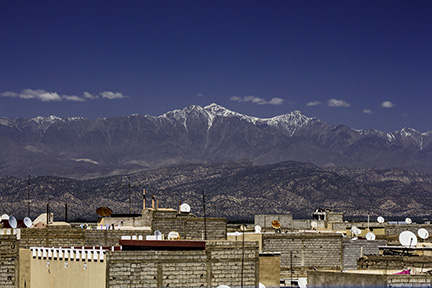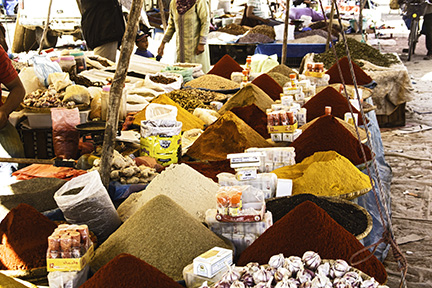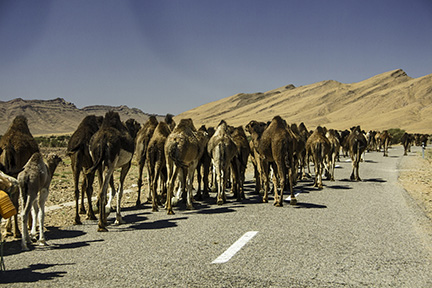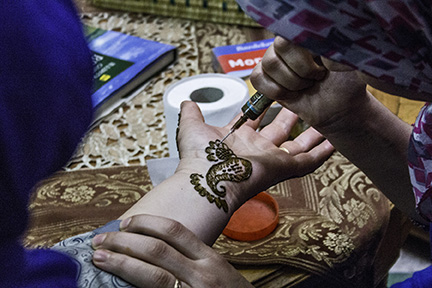Morocco 2016
Programme Details
Update as of 22 Sep 2016
The Retreat is Full
* * * WAIT LIST: For any hoping to register * * *
Please contact Jane Bayley, the registrar,
to be put on the Wait List.
In the event of any cancellations, Wait Listed people will be given the first option
to take the open retreat space, according to their order on the Wait List.
Tentative Outline for the Retreat Program
This really is a tentative or proposed outline, arrived at in December when Jane, Jilani, and Muiz did the broad planning. Once we're all on site and the retreat begins to unfold dynamically, items and timings may need to be modified, based on changes in local circumstances, as well as in response to the energetic rhythm and gestalt of the group.
A selection of photos from the 2015 retreat
(click on any image to open a larger version of the photo,
at which point you can scroll through the series
by clicking the ">" and
"<" navigation icons, which appear when you hover your mouse over the larger image)


rom old city walls













Each morning before breakfast, we'll gather on La Maison Anglaise's roof terrace to do some morning practices together as the sun rises over the hills to the east. Since it'll be December, the sun isn't rising at the "crack of doom" but around 7.15am. It's such a wonderful experience to be together with the sky above us, the snow-capped Atlas Mountains to the north, and the sun greeting us from the east.
Inspiration and the energetic calling of the moment will guide the specific practices we do each morning, but the healing breaths, a wazifa or two, perhaps some sung zikr, or a bhajan, are all practices we've used in the past.
Each day we plan to have either a mid-morning or a mid-afternoon Dances (DUP) and Practices session, plus an after-dinner evening session of Dances and Zikr, as long as folks are up for it, on days when we've been out and about.
Throughout the time at La Maison Anglaise we'll also go out for 3 short excursions requiring from a 20 minute to a little over an hour's drive in the mini-vans. There will also be a variety of Moroccan cultural experiences, either at the guesthouse, or a short walk away.
The 3 Moroccan Cultural Excursions, included in your retreat fee:
- The Busy Bee Centre
- a 20 minute drive from the guesthouse,
- this permaculture bee-keeping orchard, originally instigated by Jane, run by the Atlas Cooperative, and supported by La Maison Anglaise, is part of an eco/sustainable consiousness raising project, which focuses on sustainable and traditional livelihoods – permaculture, earth building, pigeon rearing, bamboo crafts, bee-keeping, and production of the now world-renowned argan oil derived from the nuts of native argan tree
- we'll have a picnic lunch at the Pigeon House, and an opportunity to see and perhaps buy some of the products they have for sale ... beeswax candles, honey, argan oil, etc
- see their Facebook page
- Asads Oasis
- a 45 minute drive from the guesthouse
- a very interesting area geologically, with some of the oldest fossil remains yet discovered, plus the contrast between the desert and the oasis environments
- picnic lunch again
- Imoulass, a Berber village in the High Atlas Mountains
- a little over an hour's drive from the guesthouse
- the village is high up in the foothills of the Tichka Plateau. It was once the trailhead for the old caravan routes from Mauritania, and is where Dounia's mother grew up. Dounia works at the guesthouse, and on the way down from Imoulass, we'll have lunch at her mother's current house ... probably a tagine with homemade flatbread baked right before we eat, in the outdoor wood-fired stone and clay oven (see the 4th image in the first row of photos above — Dounia's cousin is removing a flatbread from the oven.
- two local "industries" in the village where Dounia's family now lives, which are also supported by La Maison Anglaise, are roof and floor tiles made from the local clay by the village men, and olive oil based soaps made by the village women. These products provide most of the income for the village.
There is no "hard sell" or agressive encouragement to buy things at the various eco-sustainable projects. If you see something you'd like to buy, that's great. If you don't there's absolutely no pressure.
Various Moroccan Cultural Experiences
4 of these cultural experiences are included in your retreat fee, and you can choose to participate in others or repeat ones you've had for a small fee payable at the end of the retreat
- Horse-drawn caleche ride around the walled city of Taroudant, at sunset
- A visit to the nearby men's and women's Hamam (Turkish-style steam bath)
- bathing suit required (so remember to bring one to Morocco)
- a rinse with hot water, followed by the application of Moroccan black soap, sabon beldi (olive oil based), and some time to let it penetrate, which prepares the skin for exfoliation,
- a firm exfoliating scrub by a hamam attendant using an exfoliation glove that you either bring with you, or purchase at the hamam entrance
- another rinse with hot water, and the application of rhassoul, a slurry of a special red volcanic clay, which has been used for centuries to tighten and tone the skin
- another rinse, with warm, and possibly cold water
- A shopping trip to the souk, with a La Maison Anglaise guide
- the souk (aka souq) is the large covered market place, where you can browse (and buy if you wish) everything from olives, dates, coffee, and other food, to clay and ceramic tagines and other cooking and serving dishes, to leather goods, clothing, shoes, jewelry, carpets and rugs, etc, etc.
- one of the nice things about Taroudant not being a big city, and popular tourist destination, is that you don't have to deal with the incredibly "hard sell" attitudes that tourists so often are put off by in the souks of the larger cities.
- if you like, Muiz can chat with you about a few simple breath practices, and a concentration to hold while in the souk, to help keep your energy contained and grounded.
- A short Arabic lesson to learn some common and useful words and phrases
- An evening with local Sufi women,
- either they'll come to the guesthouse or we'll go to one of their houses,
- they'll share some their devotional, zikr-type singing, and perhaps we'll all participate in some impromptu dancing like we did last year
- high energy, great heart
- A Feast of the Senses
- a short experience to delight the various senses
- before dinner on the last night at the guesthouse
3-Night, 4-Day Excursion to the High Desert
- Monday 12 Dec: Campement Akka Nait Sidi, Tissint region
- We'll set off from La Maison Anglaise after breakfast in the 2 mini-vans for the rather luxurious desert camp (flush toilets, sinks, and showers in the bath house) in the high desert region of Tissint (170 miles from Taroudant).
- Just outside the northern edge of the Sahara, this area is not the rolling, ochre sand dunes found farther to the east and south. Rather this is pale sandstone hills, cliffs, dry river beds, the occasional acacia and similar type trees and other desert scrub flora, very much resembling the high deserts of Arizona and New Mexico in the US.
- We'll stop on the way at the visitor center in Talioune, the saffron capital of Morocco,

Map of the route for the desert journey
- where we can buy some Moroccan saffron, very high quality and fragrant, and very inexpensively priced.
- In the spring of 2015, a 2 gram bottle, from the 2014 autumn harvest was only 75Dh (approx $7.50 USD, £5 GBP) and a little box of 6 of the 2 gram bottles only 225Dh (approx $22.50 USD, £15 GBP).
- Amazon.com is currently selling 1 gram bottles of Taliouine saffron for $14.99 + $4.99 shipping, from an Amazon Marketplace vendor in Virgina USA.
- We'll sleep in 2-person, traditional Berber camel wool tents, on foam mattresses in wooden bed frames, under Berber woven woolen blankets
- Watch the video of the Akka Nait Sidi desert camp to get a feel for it:
- Wednesday 14 Dec: Kasbah Tizourgane
- We'll set off from the Desert Camp on Wednesday morning, heading for Tafraoute in the Ait Baha region (141 miles from the Desert Camp)
- Historically a kasbah is a walled hill fort, citadel, or fortress where a local leader lived, and where the villagers and farmers around it could retreat when where was trouble
- Kasbah Tizourgane dates from the13th century, and has been renovated as a 15-room guest house, outside of Tafraoute
- View the slide show of images (and if you read French, the information) at the facility's website: Kasbah Tizourgane
- The plan, at this point, is to stop for a picnic lunch somewhere near Chez Amaliya in Tafraoute (Google images from Tafraoute), arrive mid afternoon at the Kasbah, get settled, have a rest, then dinner, and some Dancing and Zikr in the evening
- Thursday mornings there's a local street market in a small town called Idagnedif, on a minor road near Tizourgane (Google images from Idagnedif), so we may do a brief excursion there after breakfast, return to the Kasbah for some Dancing, etc
- Followed by a picnic lunch and heading back to Taroudant, about a 2 hour drive
Final Excursion
On the Way Back to Marrakech Airport on 17 December
This year Jane has proposed the alternative of flying into and out of Marrakech instead of Agadir, as happened the previous 2 years.
It's a longer journey to Taroudant from Marrakech, some 2 hours by the motorway, but the advantage is the possibility of a spectacular scenic journey, using a longer route through the High Atlas mountains rather than the motorway, so that we can stop and spend time in the Tizi n'Test Pass (aka Tizi n'Tichka), and the Tinmel Mosque (about 100 km from Marrakech).
Because of the longer time on the road for the mini-vans and the drivers, there will be a small charge for this transport between the Marrakech airport and La Maison Anglaise, and then back to the airport on the 17th — approx £30 return, payable at La Maison Anglaise. We'll confirm the exact price once the final group size is known.
Tizi n’Test (2092m) is an awe-inspiring pass that crosses the High Atlas and connects to Taroudant and Taliouine. Blasted right through the heart of the Atlas by the French from 1926 to 1932, it was the first modern route to link Marrakesh with the Souss Valley, and offers stark, fabulous vistas of the Tizi n’Test mountains jutting out around the Nfiss Valley with clusters of villages in view hundreds of feet below.
Tinmel is one of only two mosques in Morocco that are open to non-Muslims (because they're no longer actively used). Built in 1154 CE, during the Almohad dynasty, it and the city around it were destroyed in 1256. It's been partially restored from the ruins it sank into over the centuries, and is now a monument that has been proposed for UNESCO World Heritage Site status. It's a good example of the Almohad style of mosque architecture, common to many of the active mosques in Morocco. Here are a few pics from a Google search:










